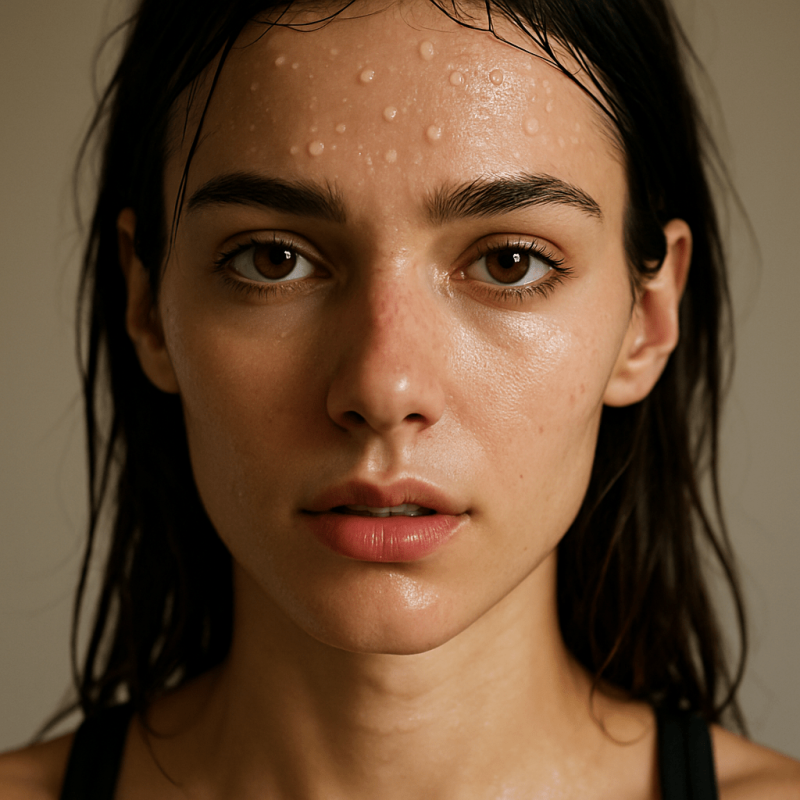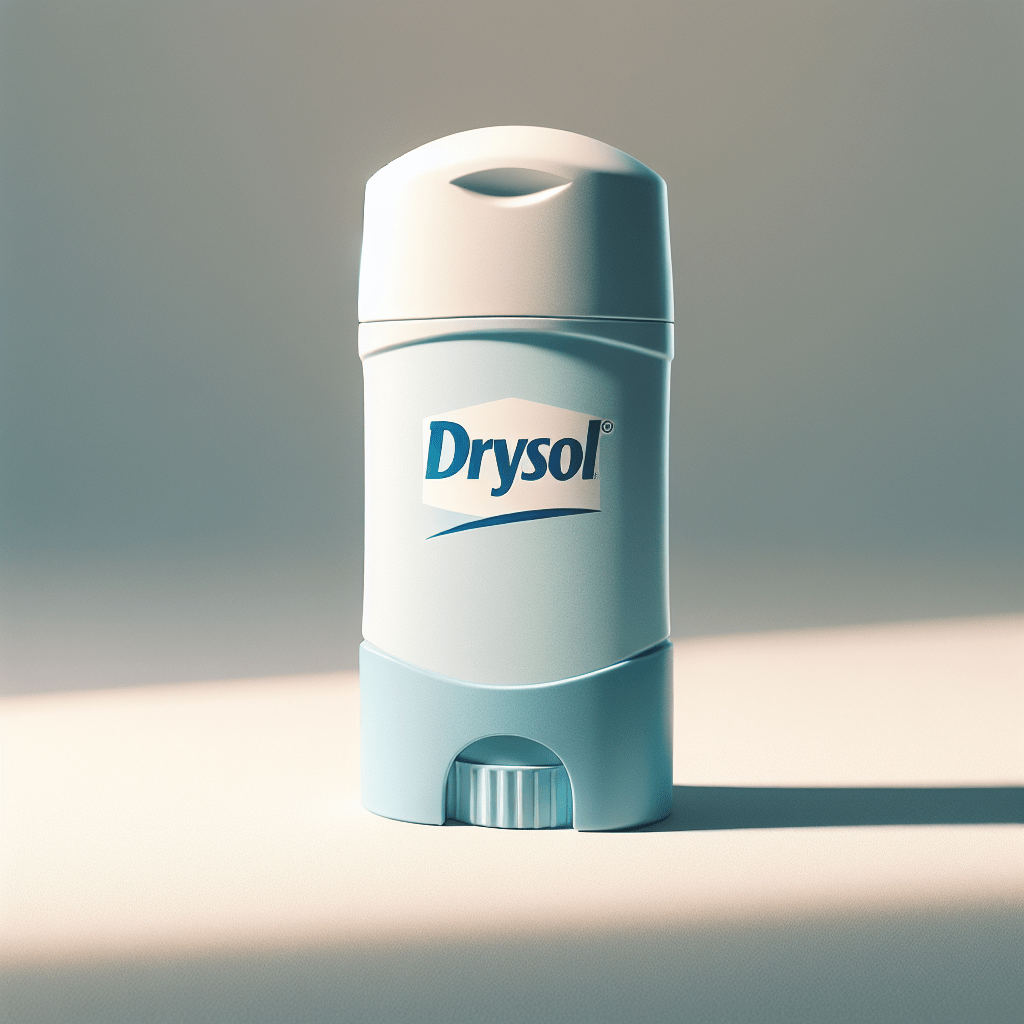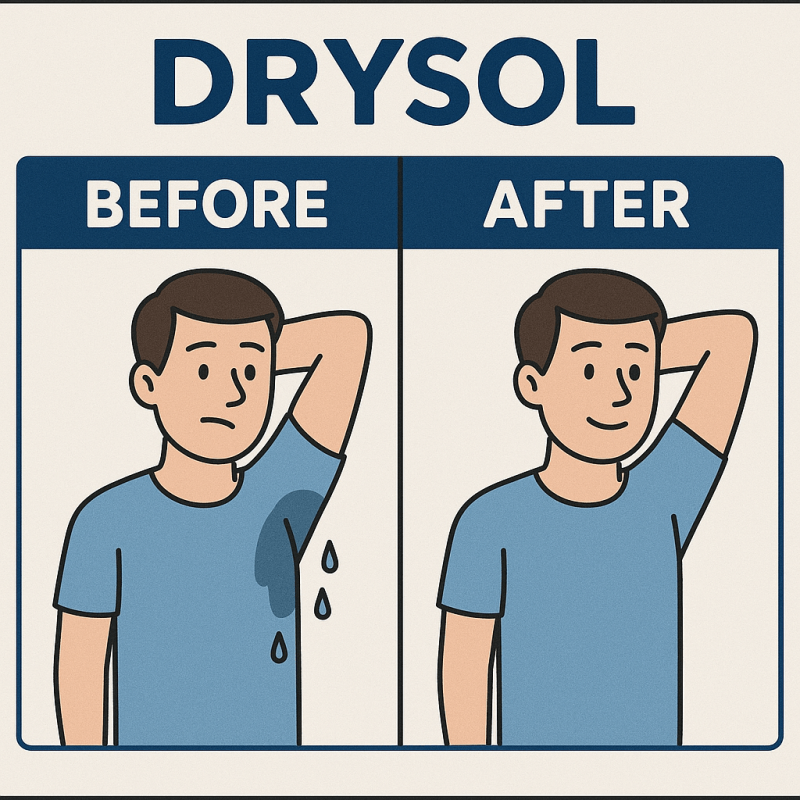

Is Drysol Safe? Understanding Its Ingredients and Side Effects
Posted by DrysolStore.com on 2025-06-10

Drysol is a widely recognized topical liquid solution designed to address excessive sweating, medically known as hyperhidrosis. For many individuals struggling with persistent underarm, hand, or foot sweating, Drysol offers a clinical strength antiperspirant option that can significantly improve daily comfort and confidence. Its effectiveness in sweat control medication has made it a go to choice for those seeking relief from excessive underarm sweating and other related conditions.
Given its potent formulation, understanding the safety profile of Drysol is essential for anyone considering or currently using this prescription strength antiperspirant. While it provides a valuable solution for sweat reduction, awareness of its ingredients and potential side effects ensures users can apply it safely and effectively. This knowledge is particularly important for individuals with sensitive skin or those prone to irritation, as well as for those exploring hyperhidrosis treatment options.
For more detailed information about Drysol and how it can help manage excessive sweating, visit Drysol. Gaining insight into the components of this sweat control medication and understanding how it works can empower users to make informed decisions about their treatment and overall skin health.

Composition of Drysol and How It Works
Primary active ingredient: Aluminum Chloride Hexahydrate
At the core of Drysolís effectiveness as a sweat control medication lies its primary active ingredient, aluminum chloride hexahydrate. This compound is a powerful agent used in many clinical strength antiperspirants to combat excessive sweating treatment. Aluminum chloride hexahydrate works by targeting the sweat glands directly, temporarily blocking the ducts that release sweat onto the skinís surface. By obstructing these sweat glands, Drysol significantly reduces perspiration, providing relief for individuals suffering from hyperhidrosis, whether it manifests as excessive underarm sweating, hand sweating, or excessive foot sweating.
The mechanism of action involves the formation of a gel like plug within the sweat gland ducts. This plug prevents sweat from reaching the skin, thereby reducing moisture and the discomfort associated with excessive sweating. Importantly, this blockage is temporary and reversible, allowing normal sweating to resume once the treatment is discontinued. The concentration of aluminum chloride hexahydrate in Drysol is typically higher than that found in over the counter antiperspirant alternatives, which is why it is recommended for more severe cases of hyperhidrosis.
Drysolís liquid formulation allows for easy application and absorption, ensuring that the active ingredient penetrates effectively to the sweat glands. This clinical strength antiperspirant is often applied at night, during nighttime antiperspirant application, when sweat production is naturally lower, allowing the aluminum chloride hexahydrate to work more efficiently. This targeted approach helps maximize the productís efficacy while minimizing potential irritation.
Additional inactive ingredients
While aluminum chloride hexahydrate is the star ingredient in Drysol, the formulation also includes several inactive components that play crucial roles in product stability, skin absorption, and user comfort. These inactive ingredients are carefully selected to enhance the overall performance of the sweat reduction product without causing irritation or adverse reactions.
Common non irritating substances found in Drysolís formulation include solvents and stabilizers that help maintain the liquidís consistency and ensure the active ingredient remains effective over time. These components also facilitate the smooth application of the product, allowing it to spread evenly across the skin and penetrate the sweat glands efficiently. The balance of these inactive ingredients is essential to prevent excessive dryness or discomfort, which can sometimes occur with prescription sterngth antiperspirant use.
In addition to improving absorption, these inactive ingredients contribute to the productís shelf life and ease of use. They help prevent the active ingredient from degrading or reacting with environmental factors such as air and moisture. This careful formulation ensures that Drysol remains a reliable underarm sweating solution for users who depend on it for daily sweat control.
Comparison to other antiperspirant products
Drysol stands out among hyperhidrosis topical treatment options due to its unique formulation and prescription strength. Unlike many over the counter antiperspirant alternatives, which typically contain lower concentrations of aluminum based compounds, Drysol offers a higher potency that is necessary for effectively managing severe cases of excessive sweating. This distinction is critical because mild antiperspirants often fail to provide adequate relief for individuals with intense sweat gland activity.
The clinical strength antiperspirant nature of Drysol means it is specifically designed to deliver more robust sweat gland blockage treatment. This makes it a preferred choice for those who have not found success with standard products or who require a more targeted approach to sweat reduction. While over the counter options may be suitable for mild sweating, Drysolís prescription strength antiperspirant formulation addresses the root cause of hyperhidrosis more directly and effectively.
Furthermore, Drysolís liquid formulation allows for precise application to affected areas such as underarms, hands, and feet, which are common sites of excessive sweating. This targeted application helps minimize unnecessary exposure to surrounding skin, reducing the risk of irritation. The productís reputation as a reliable underarm sweating solution is supported by its long standing use in clinical settings and positive user experiences.
In summary, the combination of aluminum chloride hexahydrate at a higher concentration, carefully chosen inactive ingredients, and a liquid formulation tailored for nighttime antiperspirant application makes Drysol a standout option among sweat reduction products. Its prescription strength and proven mechanism of action provide a level of efficacy that over the counter alternatives often cannot match, making it a valuable tool in the management of hyperhidrosis.

Potential Side Effects and Risks Associated with Drysol
Common local reactions: skin irritation, redness, and itching
Drysol, as a clinical strength antiperspirant, is highly effective in managing excessive sweating treatment, but its potency can sometimes lead to local skin reactions. The most frequently reported side effects include skin irritation, redness, and itching at the application site. These reactions occur because aluminum chloride hexahydrate, the active ingredient, can be mildly corrosive to the skin, especially when applied to broken or freshly shaved skin. The concentration of this ingredient in Drysol is higher than in typical over the counter antiperspirant alternatives, which increases the likelihood of these local effects.
While these side effects are common, they are generally mild and temporary. Most users experience some degree of tingling or stinging during the initial applications, which often subsides as the skin adjusts to the treatment. Redness and itching may also occur but usually resolve within a few days of continued use or after temporarily discontinuing the product. It is important to note that these reactions are not signs of an allergic response but rather a normal irritation caused by the sweat gland blockage treatment.
To minimize irritation, practical tips include applying Drysol only to completely dry skin, preferably during nighttime antiperspirant application when sweat production is lower. Avoiding application immediately after shaving or exfoliating can also reduce sensitivity. Using a gentle moisturizer on unaffected areas and allowing the product to dry fully before dressing can help protect the skin. If irritation persists or worsens, reducing the frequency of application or consulting a healthcare provider for alternative hyperhidrosis treatment options is advisable.
Possible allergic reactions and sensitivity
Although uncommon, some individuals may experience allergic reactions or heightened sensitivity to Drysolís ingredients. Unlike typical irritation, allergic responses involve the immune system and can present with symptoms such as severe itching, swelling, blistering, or a rash that extends beyond the application site. These symptoms indicate that the skin is reacting adversely to one or more components in the prescription antiperspirant, including aluminum chloride hexahydrate or inactive ingredients.
To identify potential allergies before widespread use, patch testing is recommended. This involves applying a small amount of Drysol to a limited skin area and monitoring for any adverse reactions over 24 to 48 hours. If signs of allergy develop, such as intense redness, swelling, or blistering, the product should be discontinued immediately, and medical advice sought. In some cases, alternative hyperhidrosis topical treatments with different formulations may be necessary to avoid allergic reactions.
Users with a history of sensitive skin or allergies to antiperspirant ingredients should exercise caution and discuss their concerns with a healthcare professional before starting Drysol. Early recognition of allergic symptoms and prompt discontinuation of the product can prevent more serious complications and ensure a safer experience with sweat reduction products.
Long term safety considerations
Concerns about the long term safety of Drysol often focus on the potential for systemic absorption of aluminum chloride hexahydrate and its possible toxicity. However, extensive research and clinical experience have shown that when used as directed, Drysolís active ingredient remains largely localized within the sweat glands and skin surface, with minimal systemic absorption. This localized action significantly reduces the risk of aluminum related toxicity or other systemic side effects.
Medical experts generally agree that prolonged use of Drysol as a sweat control medication is safe for most individuals. The temporary sweat gland blockage treatment does not cause permanent damage to the glands, and normal sweating typically resumes once the product is discontinued. Regular follow up with a healthcare provider can help monitor skin health and address any concerns that arise during long term use.
It is important to use Drysol according to guidelines, including proper application techniques and frequency, to maintain safety and effectiveness. For those worried about long term effects, discussing hyperhidrosis treatment options with a dermatologist or specialist can provide reassurance and alternative strategies if needed. Overall, Drysol remains a trusted and effective option for managing excessive underarm sweating and other forms of hyperhidrosis when used responsibly.

Guidelines for Safe Use and When to Seek Medical Advice
Proper application techniques to ensure maximum efficacy and reduced side effects
Using Drysol correctly is essential to achieving the best results while minimizing the risk of side effects. As a clinical strength antiperspirant, Drysolís effectiveness depends heavily on proper application techniques. One of the most important recommendations is to apply the product during nighttime antiperspirant application. Sweat production naturally decreases during sleep, allowing the aluminum chloride hexahydrate to penetrate the sweat glands more effectively and form the sweat gland blockage treatment that reduces perspiration.
Before applying Drysol, it is crucial to ensure the skin is completely dry and clean. Moisture on the skin can increase the likelihood of irritation and reduce the productís absorption. Many users find it helpful to apply Drysol after showering and thoroughly drying the targeted areas, such as underarms, hands, or feet. Avoid applying the product immediately after shaving or exfoliating, as broken or sensitive skin can lead to increased irritation.
Post application care also plays a role in reducing side effects. Allow the product to dry fully before dressing or covering the treated area to prevent rubbing or transfer to clothing. Following the proper dosage and frequency is equally important; overuse can heighten the risk of skin irritation without improving results. Typically, Drysol is applied once daily at night, with adjustments made based on individual response and medical advice.
By adhering to these guidelines, users can maximize the benefits of this prescription strength antiperspirant while minimizing discomfort, making it a reliable underarm sweating solution and effective sweat control medication for managing excessive sweating treatment.
Identifying contraindications and who should avoid Drysol
While Drysol is a valuable hyperhidrosis topical treatment for many, it is not suitable for everyone. Certain conditions, age groups, and skin types may increase the risk of adverse reactions or reduce the productís safety and effectiveness. For example, individuals with broken, irritated, or inflamed skin should avoid using Drysol until the skin has fully healed. Applying the product to compromised skin can cause severe irritation and discomfort.
Children and adolescents under a certain age may also be advised against using Drysol unless under strict medical supervision, as their skin can be more sensitive to the high concentration of aluminum chloride hexahydrate. Additionally, people with known allergies or sensitivities to any of the ingredients in Drysol should avoid its use to prevent allergic reactions.
Those with certain medical conditions, such as kidney disease or skin disorders, should consult a healthcare provider before starting Drysol. Pregnant or breastfeeding women should also seek medical advice to ensure the productís safety for their specific situation. Consulting a healthcare professional before beginning any prescription strength antiperspirant ensures that the chosen hyperhidrosis treatment options align with individual health needs and minimize risks.
Managing side effects and when to discontinue use
Monitoring for side effects is an important part of using Drysol safely. Mild skin irritation, redness, or itching are common during the initial phase of treatment and often improve as the skin adjusts. However, if these symptoms persist, worsen, or become painful, it may be necessary to adjust the usage pattern or temporarily discontinue the product. Applying Drysol less frequently or reducing the amount used can help alleviate irritation while maintaining some level of sweat control.
In cases where allergic reactions or severe sensitivity occur, characterized by swelling, blistering, or intense rash, immediate discontinuation is essential. Seeking medical advice promptly can help address these reactions and guide users toward alternative sweat reduction products or hyperhidrosis treatment options that are better suited to their skin type.
Long term users should maintain regular communication with their healthcare provider to evaluate the ongoing safety and effectiveness of Drysol. If excessive underarm sweating or other symptoms return after discontinuation, a healthcare professional can recommend adjustments or additional treatments. By carefully managing side effects and knowing when to seek medical advice, users can safely benefit from this prescription strength antiperspirant as part of their overall excessive sweating treatment plan.

Understanding the Safety and Effectiveness of Drysol
Drysol is widely regarded as a safe and effective option for managing excessive sweating when used properly and under the guidance of a healthcare professional. Its well studied active ingredient, aluminum chloride hexahydrate, combined with a carefully formulated liquid base, provides a targeted approach to sweat gland blockage treatment. This clinical strength antiperspirant has been trusted by many individuals facing challenges with hyperhidrosis, offering relief where over the counter antiperspirant alternatives may fall short. The prescription strength antiperspirantís ability to reduce excessive underarm sweating, as well as sweating on hands and feet, makes it a versatile sweat control medication for those seeking a reliable underarm sweating solution.
When applied according to recommended guidelines, Drysolís benefits often outweigh the risks of side effects. The productís design for nighttime antiperspirant application and its specific concentration help maximize efficacy while minimizing irritation. Users who follow proper application techniques and take precautions to avoid broken or sensitive skin typically experience positive outcomes. This balance of potency and safety is why Drysol remains a preferred choice among hyperhidrosis treatment options for many patients and healthcare providers alike.
Being informed about Drysolís composition and potential side effects empowers users to make thoughtful decisions about their treatment. Understanding how the active and inactive ingredients work, recognizing common local reactions, and knowing when to seek medical advice can help individuals manage their condition confidently. This knowledge supports a proactive approach to sweat reduction products, ensuring that users can maximize the benefits of Drysol while minimizing any risks. Ultimately, this empowers those affected by excessive sweating to regain control over their daily lives with a trusted and effective solution.




